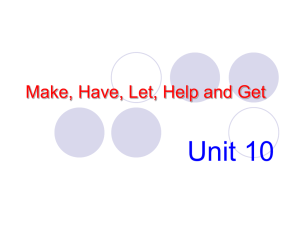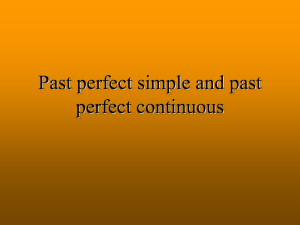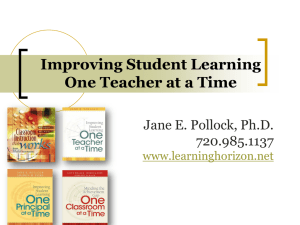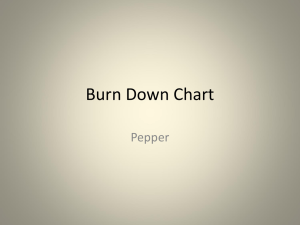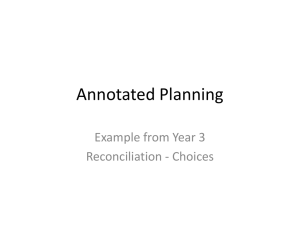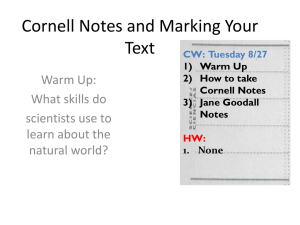PowerPoint Presentation - Doctor, can you turn off Dad`s pacemaker
advertisement
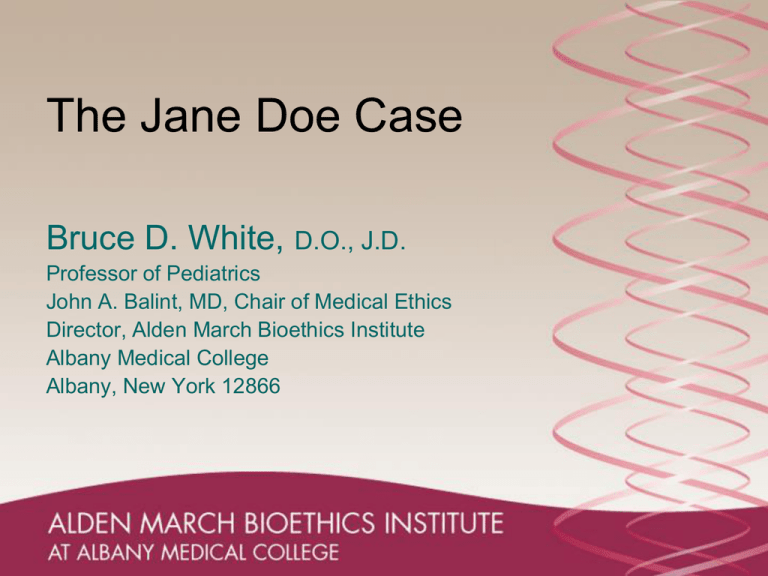
The Jane Doe Case Bruce D. White, D.O., J.D. Professor of Pediatrics John A. Balint, MD, Chair of Medical Ethics Director, Alden March Bioethics Institute Albany Medical College Albany, New York 12866 Objectives • Illustrate some of the ethical dilemmas that individuals encountered in the Jane Doe case, Nashville, 1990. • Explain the difference between the deaths of individuals wanting to die and those not wanting to die yet not wanting to live with lifesustaining medical treatments either. • Describe a process to analyze ethical dilemmas in clinical practice. Snyder B. Woman sues for right to die. The Nashville Banner. 1990;7 Feb:1 1984 • Jane Doe is married and lives outside Murfreesboro on a farm that she inherited from her parents • She and her husband have three sons • She is the “glue” that holds the family together--keeps house, cooks, washes, keeps the farm books, does the taxes, makes the decisions about crops and animal purchases and sales Late Summer 1984 • Jane Doe notices that she’s “just not able to screw the tops on the canning jars as tightly as she once could” • She visits her doctor in Nashville--wasting of the finger muscles is noticeable, she even shuffles when she walks • The healthcare team suspects a neuromuscular disorder • Amyotrophic lateral sclerosis is confirmed amyotrophic lateral sclerosis Abbreviated ALS. A chronic, progressive disease marked by gradual degeneration of the nerve cells in the central nervous system that control voluntary muscle movement. The disease causes muscle weakness and atrophy and usually results in death. Also called Lou Gehrig’s disease. 1984-1986 • Jane Doe learns to cope as she deteriorates • She uses occupational therapy aids, a computer • She hires additional help as needed • She remains the family “glue” that she has always been • The family too copes as well as it can Winter 1986 • Jane Doe contracts a viral upper respiratory infection, it progresses to a pneumonia • She goes to her local emergency room, in marked respiratory distress; she’s immediately transferred to Saint Thomas in Nashville and intubated in the emergency department • The pneumonia clears after a few days treatment in the intensive care unit Winter 1986 • However the team is not able to wean Jane from the ventilator • After a few weeks a tracheotomy is performed • She goes home on a ventilator after a six week hospitalization (remarkable for the time) • On discharge, she vows “I’ll never be admitted to the hospital again” 1986-1990 • Jane Doe continues to cope as she deteriorates • The family hires a full-time aide who nurses her and helps with the household chores (growing more close to Jane and her family, the aide and her husband build a house on the farm property) • Jane becomes more proficient with the computer (using now a light pen to point and click) • She becomes less and less mobile • A feeding tube is placed for nutritional support, but Jane continues to eat, chew, and swallow January 1990 • Jane’s volitional movements are severely limited: she can blink her eyes, raise and lower her right thumb, chew and swallow some little food • On a routine visit to her internist--the same physician who made the ALS diagnosis--Jane hands the doctor a computer generated note: “In May, I will have lived to see my youngest child graduate from college, after that I want you to take me off the ventilator.” • Jane’s husband confirms that she typed the note What’s to be done? How should the physician respond? Is this an ethical dilemma? Why? Shared Decision Making Model Beneficence Nonmaleficence Institutional Preferences Policies & Procedures Medical Indications-Physician(s) Preferences Informed Consent Autonomy Patient Preferences + decision making capacity Justice Best interests Contextual Features Delivery Systems Considerations Economic Considerations Legal Considerations Theological Considerations Psycho-social Considerations Substituted judgment - decision making capacity Patient’s Representative Quality-of-Life Considerations Modified from Jonsen AR, Siegler M, Winslade WJ. Clinical Ethics, 6th ed. New York: McGraw-Hill, Inc., 2004. Autonomy Informed Consent Patient Preferences + decision making capacity - decision making capacity Beneficence Nonmaleficence Medical Indications-Physician(s) Preferences Institutional Preferences Policies & Procedures Informed Consent + decision making capacity - decision making capacity If the patient and physician agree on an interventional goal, where’s the dilemma? Where’s the problem? Reasons Healthcare Team Members Ask for a “Clinical Ethics Consult” • There is a family conflict. • The healthcare team itself is in conflict: physician-physician disagreement; physiciannurse disagreement; a reasonable difference of opinion about diagnosis, prognosis, treatment options; the patient or surrogate is receiving “mixed messages.” • There is difficulty in identifying a surrogate or determining patient wishes. Take Home Lessons Thus Far • Using the Jonson-Siegler-Winslade clinical ethics decision making model, this is an “above-the-line” case. • The medical indications box is clear, the patient preferences box is clear. • As hard as it is, clinical ethics decision making doesn’t get any easier than this case. So, what’s the problem in the Jane Doe case? • There is a no family conflict. • The healthcare team is certain about the diagnosis, prognosis, treatment options. The patient--having lived with the illness for sixseven years understands the disease very well. • The patient has decision making capacity and has made her wishes clear. The wishes can be further clarified with patient “conversation.” So again, how should the physician respond? What immediate problems might the physician encounter if he takes Jane Doe off the ventilator? 1 Is this murder? Assisted suicide? (a criminal investigation and prosecution resulting in fine or imprisonment) This is not assisted suicide or murder. • Competent adult patients have a right to refuse unwanted, even though lifesustaining medical treatment. • White BD, Siegler M, Singer PA, Iserson KV. What does Cruzan mean to the practicing physician? Arch Intern Med. 1991;151:925-925-928. 2 Might it be medical malpractice? (a civil action for damages) This is not medical malpractice. • In order to sustain a medical malpractice claim, plaintiff must show (1) duty; (2) breach of duty; (3) proximate causation; and (4) damages. There is evidence to the contrary in this case. • However, there may very well be a claim for battery if the physician continues to provide unwanted medical treatment (“offensive touching”) in the face of the patient’s objections. 3 Might it violate a regulatory or professional (normative ethics) standard? (an administrative proceeding resulting in licensure revocation or suspension or civil monetary penalty) Removing Jane Doe from the ventilator violates no regulatory or professional standard. Recall the goals of the EPEC (Education for Physicians on End-of-Life Care) Project sponsored now by Northwestern University and formerly funded by the Robert Wood Johnson Foundation and the American Medical Association. 4 Might the public respond negatively? (a public relations or business relations issue) The public supports the rights of patients to refuse unwanted, even life-sustaining medical treatment. • High’s ruling courageous, fitting [editorial]. The Nashville Banner. 1990;13 Feb:10. • Recall the initial clamor for Living Wills legislation to protect patients from aggressive physicians who wanted to burden patients with unwanted, even life-sustaining medical treatment. 5 Would removing the ventilator violate any religious tenet? For the patient? For the physician? Both? (a theological issue) 6 Would it matter if this action were precipitated by pure financial concerns? (the patient has reached the $1M cap on health insurance contributions or the family farm is at risk (a contractual or economic issue) 7 Might removing the ventilator precipitate a family crisis? Or, one for the faithful caregiver? (a psycho-social or community issue) 8 How might it be done painlessly and compassionately? (a technical issue) August 1990 Jane Doe died peacefully at home attended for her long-time friend and aide. The ventilator was removed after she was sedated with a benzodiazepine and morphine. She died within minutes. After saying goodbye and too emotionally distraught by the prospects of her death to be present, her husband and sons waited nearby until word of her death came. Take Home Lessons Revisited • Resolving clinical ethics dilemmas does not always lead to “good” outcomes but perhaps better than “bad” outcomes. • The end result may be one that leaves those involved more at peace with their consciences. • As hard as it is, clinical ethics decision making doesn’t get any easier than this case. For Further Reading White BD. Drugs, Ethics, and Quality of Life: Cases and Materials on Ethical, Legal, and Public Policy Dilemmas in Medicine and Pharmacy Practice. New York: Informa USA, 2007. Objectives • Illustrate some of the ethical dilemmas that individuals encountered in the Jane Doe case, Nashville, 1990. • Explain the difference between the deaths of individuals wanting to die and those not wanting to die yet not wanting to live with lifesustaining medical treatments either. • Describe a process to analyze ethical dilemmas in clinical practice. Questions? Comments?
